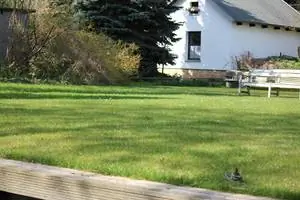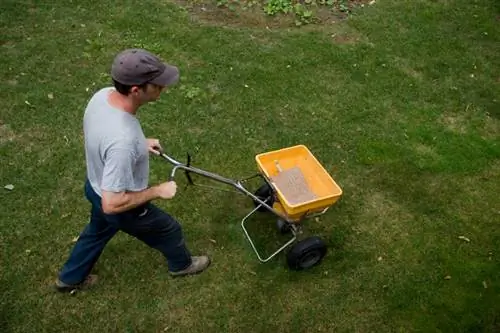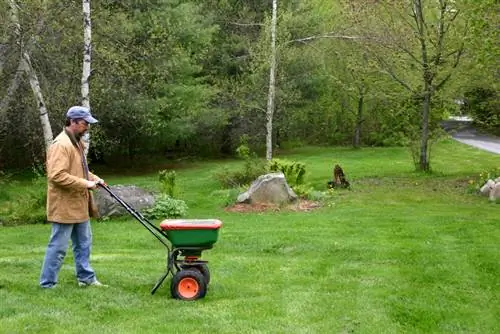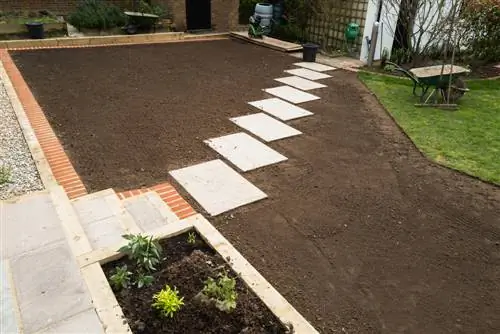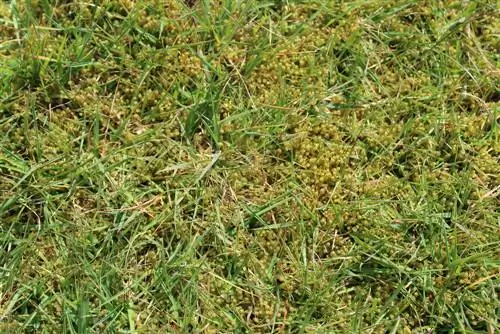- Author admin [email protected].
- Public 2023-12-16 16:46.
- Last modified 2025-06-01 06:02.
A he althy and beautiful lawn needs careful care all year round. Regular mowing is just as important as fertilizing, watering and scarifying. You can find out which care work you have to do and when in this comprehensive article.

Overview: Proper lawn care throughout the year
Most people probably know that as a lawn owner you should mow occasionally between May and September and water the lawn on hot days. However, that's not the end of lawn care, as a he althy lawn needs attention all year round. For this reason, at the beginning of this guide there is a list of the necessary work, which we have staggered by season for a better overview.
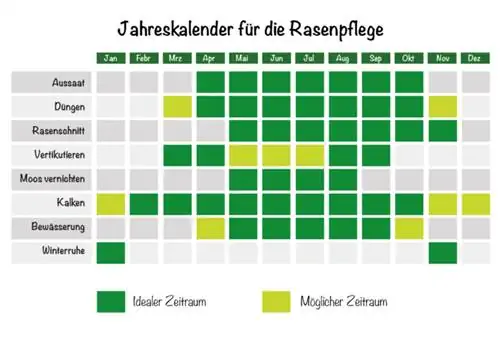
Lawn care in spring
Spring covers the months March to May. Now it's time to remove the traces of winter and repair damage to the lawn caused by frost, wetness and snow. In addition, the lawn must be prepared for the new season so that the grass grows strong and he althy.
| Work to be done | Ideal time | Implementation |
|---|---|---|
| Removal of dead lawn grasses | March to April | Raking the lawn with a leaf rake |
| Verticutting | March to April | electric or manual |
| First fertilization | Early to mid-March at least ten degrees Celsius | Applying lawn fertilizer |
| Fighting moss | at the time of first fertilization | Use lawn fertilizer with moss killer |
| First mowing | approx. ten days after the first fertilization | don't cut too deep, repeat regularly |
| Repairing the lawn | from April | reseeding bare spots |
| New installation | from April | New lawn installation including careful soil preparation |
Tip
It is difficult to grow a beautiful, green and he althy lawn on clayey soils in damp areas. On such soils it can make sense to lay turf on a bed of sand and gravel. This ensures good drainage, and lawns should always be slightly sloping. This is the only way to prevent water from standing on the lawn.
Lawn care in summer
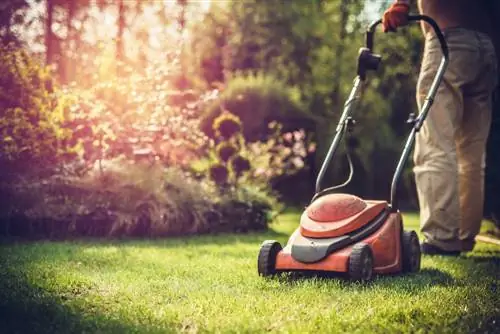
The lawn should be mowed several times in summer
The summer months between June and August also mean a lot of stress for a lawn: the area is now subject to particularly high levels of stress because it is walked on frequently. Heat and drought also cause problems for the grasses. These works are due at this time of year.
| Work to be done | Ideal time | Implementation |
|---|---|---|
| Regular mowing | April to September, every five to seven days | don’t cut too short |
| Irrigation | once or twice a week, preferably early in the morning or when the sky is overcast | Plan 10 to 20 liters of water per square meter so that the grass has deeper roots (under no circumstances water in small doses every day!) |
| Second lawn fertilization | from June | Use slow-release fertilizer |
| Weed control | from June | Find out the cause of weed growth, e.g. E.g. unsuitable pH value and eliminate cause, use fertilizer with weed killer |
Lawn care in autumn
There is still plenty to do between September and November to ensure that the lawn starts the winter rest phase well and survives the cold season with as little damage as possible.
| Work to be done | Ideal time | Implementation |
|---|---|---|
| Mowing | until October / possibly also until November | don’t mow too deep |
| Third lawn fertilization | September to October | use potassium-rich fertilizer to make the grasses more resistant to pathogens and frost |
| Repair / new installation | September to October | if the weather conditions are warm enough |
| Removal of autumn leaves | from October | Rot can develop under a cover of leaves, so remove leaves by gently raking |
Lawn care in winter
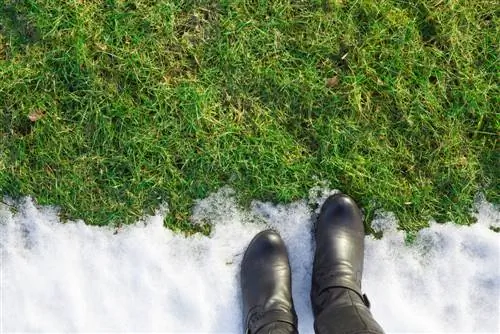
In winter the lawn should be walked on as little as possible
The lawn is in hibernation between November and February. During this time, you should enter the area as little as possible, especially in frosty weather or snowfall. The ideal time for liming the lawn is early spring: the chances of this happening are particularly good in February. Alternatively, late autumn between October and November is also suitable for this measure.
Excursus
Launch correctly and avoid problems
Many lawns struggle with diseases and weeds because they were simply sown in a location that was too dark. Grasses thrive particularly poorly under a dense canopy of leaves, as lack of light and water as well as the drops falling from the leaves significantly hinder grass growth. Moss is often the result.
Mow and trim regularly
Mowing the lawn is one of the most important lawn care measures. Regular mowing ensures that the grasses are continually stimulated to grow and thus form a dense, upright turf. Weeds have little chance of getting through here.
When and how often do you mow?
Depending on the region and weather, the mowing season begins between March and April and ends between October and November. How often you actually have to mow depends on the type of lawn. For example, commercial lawns have to be cut back much more often than a wildflower meadow. The weather also determines the frequency of cutting, as the growth of the grass depends on the weather. During dry periods, for example, grass grows very slowly and therefore needs to be mowed less frequently than in rainy and warm phases. The general rule of thumb is that you should mow about once a week. When it's frosty, the lawnmower stays in the shed.
The right time
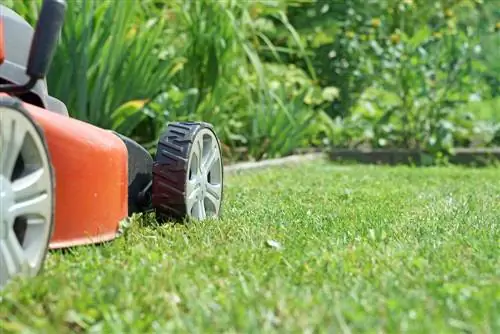
Lawn should be mowed when it is neither damp nor too warm
Lawns are best mowed when the grass is dry. The early morning hours and shortly after a downpour are therefore not the best times to cut the lawn. The hot midday hours are also not suitable, as the grass is only exposed to greater stressors. Therefore, avoid the early evening hours if possible.
At what height should you mow lawn grass?
Lawn must under no circumstances be mowed too deeply, as this creates unsightly bare spots and also promotes the growth of moss and weeds. If possible, stick to the so-called rule of thirds, according to which the grasses are always trimmed by a third of their current height. According to this rule, a lawn that has grown six centimeters high is shortened by two centimeters and thus has a height of four centimeters - the grasses of a commercial lawn should not be cut back much lower.
Where do the lawn clippings go after mowing?
The clippings that come from mowing the lawn definitely don't belong in the trash, but can still be used very well in the garden.
- Compost: Mix the fresh lawn clippings with other compost materials or spread them as a thin layer between other layers of compost. Composting preserves the nutrients from the grasses and ensures a balance between carbon and nitrogen in the compost pile.
- Mulching material: However, you don't just have to let the lawn clippings rot on the compost, you can also distribute them between vegetable beds or under bushes and trees. Here the material provides additional nutrients and at the same time prevents weed growth.
- Lawn Fertilization: If you mow with a special mulching lawn mower, you can leave the heavily shredded clippings on the lawn as an additional source of nutrients. However, this mulching does not replace fertilization.
Water your lawn properly
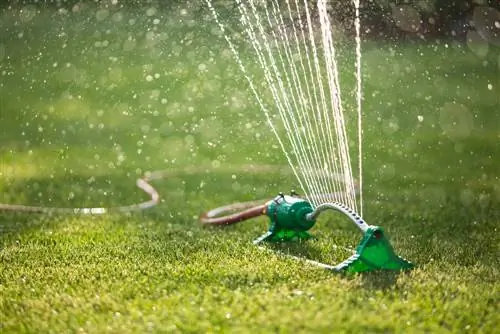
Lawn should be watered thoroughly in the morning or evening if possible
Lawn grasses consist of 80 to 90 percent water and therefore require a lot of water - especially in dry conditions. On average, you can expect to use around 2.5 liters of water per square meter of lawn during the summer months. However, this is only an average, because the actual water requirement depends on various factors:
- Location: Lawns in very sunny, exposed locations generally need more water than lawns in partially shaded places.
- Weather: On hot summer days, the water requirement is also higher than at cooler times.
- Soil type: Some soils are good at storing water, which is why you have to water less often, for example on light sandy soil.
- Lawn type: The water requirements also vary considerably between different types of grass.
Time
The lawn needs to be watered urgently if the blades do not stand up again or only very slowly after being walked on. Prints should not remain visible for longer than 15 to 20 minutes, otherwise it is high time to water. For watering, prefer the early morning hours, as evaporation rates from sunlight and wind are low at this time. This saves you water. But the lawn can still be watered in the evening, but only at midday if it is absolutely necessary and the plants are thirsty.
Frequency
Don't make the mistake of watering your lawn in small amounts every day. This only ensures that the grasses only develop shallow roots and cannot draw water from the soil themselves. However, you can achieve deeper rooting if you only use the watering can once or twice a week. The soil should then be well moistened to a depth of around ten centimeters, which is why you need to sprinkle the area with around ten to 20 liters of water per square meter. A rain gauge will help you determine the right amount.
Automatic watering
With such amounts of water, you won't want to water your lawn with a watering can. An automatic irrigation system is therefore necessary, where you can choose between hoses or sprinklers with or without a timer. Sprinklers are the better choice for larger areas, as they are more likely to achieve even and sufficient moistening.
Scarifying and aerating

Dethatching makes sense when weeds or moss grows in the lawn
Once a year it's time to clear the lawn of all thatch as well as moss and weeds. In spring you should scarify the area with a suitable device, removing the thatch and ensuring that the lawn is aerated.
Time
The best time for this measure is late spring, as the lawn can then best compensate for any damage caused by scarifying with new growth. March and April are the best months for this, although you can also use the scarifier again between August and September if necessary. To ensure that the measure has the best possible success, you should fertilize about ten days before scarifying.
Implementation
Do not cut deeper than a maximum of one to two millimeters into the ground, as this will have a negative impact on the later lawn density and you primarily want to remove the thatch. Always scarify lengthwise and crosswise, then remove the scarifying material from the lawn and smooth the surface. The best way to do the latter is with the first lawn cut of the year.
This clear video shows whether it is better to scarify the lawn electrically or by hand and what you need to pay attention to:

Subsequent work
You may want to reseed after scarifying to close any gaps in the turf. It also makes sense to spread coarse sand on the lawn (approx. three to four liters per square meter) to make the soil more permeable. However, this measure is only necessary on compacted and heavy soils. Instead of sand, primary rock powder can also be used, which also supplies the lawn with important trace elements.
Optimal fertilization for beautiful and he althy grass
“Complaining about the poor lawn doesn’t help, the right treatment is important.”
Proper fertilization is essential when caring for your lawn. All plants - including grasses - need sufficient nutrients in the right composition in order to grow and thrive. Fertilizing three times a year is particularly important for lawns that are mowed regularly in order to replenish nutrients lost through cutting. In addition to under-supply, it is also important to avoid over-fertilization, as this also has harmful consequences.
Which fertilizer is particularly suitable for fertilizing lawns?

The lawn should be fertilized with a slow-release fertilizer
Choose special long-term fertilizers for lawn fertilization, as with these - in contrast to quick-acting instant fertilizers - over-fertilization is difficult. These fertilizers only release their nutrients slowly and gradually into the soil, while with short-term fertilizers all ingredients are immediately available to the plants. This may be useful in the case of deficiency symptoms, but not in normal lawn fertilization.
Another disadvantage of instant fertilizers is that you have to feed your lawn much more often than would be the case with a long-term fertilizer - depending on the product, they last around six to twelve weeks. Make sure to use a complete fertilizer with a balanced mix of nutrients. In addition to the most important nutrients nitrogen, phosphorus and potassium, minerals and trace elements should also be present.
How much fertilizer is needed?
How much fertilizer you actually need to apply depends largely on the composition of your garden soil. To avoid over- or under-supply, you should have a soil test carried out every three years. With the evaluation you will receive specially adapted nutrient recommendations with which you can calculate the amount of fertilizer required. The formula for this is:
Amount of pure nutrient (grams per square meter) multiplied by 100 and then divided by the nutrient content of the fertilizer in percent gives the required amount of fertilizer in grams per square meter
The amount of pure nutrients can be found in the fertilizer recommendation from the soil laboratory, while the percentage nutrient content of the fertilizer is stated on the product packaging. The information always applies to certain nutrients, such as nitrogen.
Tip
However, do not apply the calculated amount of fertilizer all at once, but spread it over three to four annual applications.
How do you apply fertilizer evenly to the lawn?
It is best to apply the fertilizer to dry lawns so that the granules do not stick to the damp stalks. For even distribution, use a spreader, but there is basically nothing wrong with traditional spreading by hand. To do this, take the fertilizer granules in your hand and throw them out widely. Then water the lawn so that the fertilizer can seep into the soil. In addition, the area should not be mowed or walked on for at least two days - especially not by children or pets.
When is the right time to fertilize?
The lawn is optimally fertilized three times a year:
- Spring fertilization: at the start of the growth period, for regeneration after winter
- Fertilization in early summer: Nutrient requirements are highest in early summer, which is why fertilization is carried out again. This fertilization also strengthens the lawn against the heat.
- Autumn fertilization: Potassium-based fertilization protects the grasses from the winter harshness and makes them more resistant to frost.
Lime the lawn - when and with what?
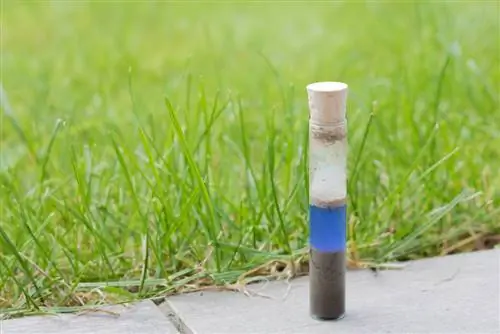
If the soil is too acidic, using lime makes sense
Due to, among other things, repetitive mowing, but also due to other factors, the pH value of the lawn soil decreases over time. It acidifies, which in turn is reflected in poorer grass growth and an increased occurrence of undesirable plants - such as moss. Ideally, the soil should have a pH value between 5.5 and 6.5, which is why liming the lawn from time to time is a sensible measure.
When should you lime the lawn?
However, don't make the mistake of just liming. In fact, you should first determine whether applying lime is even necessary. So-called indicator plants, for example, which grow primarily on acidic soils, indicate a need. The increased appearance of moss, sorrel, horsetail, pansies, horn trefoil or daisies is always a warning sign. A subsequent pH test - either in a specialized laboratory or using test sticks from the hardware store - provides clarity. If there is actually a need, lime the lawn in early spring.
How to properly lime the lawn
Lawn or garden lime (pure lime is completely sufficient, additives or any special types of lime such as algae lime are not necessary) are in principle applied in the same way as fertilizer. However, make sure to wear a respiratory mask, a face mask, safety glasses and gloves. Apply the lime on a calm, dry day and then let the lawn rest for at least four weeks.
Excursus
Where can I find a suitable institute for soil analysis?
To find a reputable soil analysis institute in your area, you can send an inquiry to the Association of German Agricultural Investigation and Research Institutes (VDLUFA).
Frequently asked questions
What's the point of mulching the lawn?
Mowing normally removes valuable nutrients from the lawn, and the soil gradually becomes acidic. You can minimize both by leaving the chopped clippings on the lawn.
There's so much moss growing in my lawn. What can I do about it?
Moss in the lawn can have various causes: There may simply be too little sun shining on the lawn and/or the soil may be too moist. Soil with a pH value that is too low is also ideal for moss. Find out the cause and eliminate it, along with the moss. Rake this carefully out of the lawn and reseed any bare spots.
How do I choose the right lawn mixture?
Lawn is by no means the same as lawn, as there is the right mixture for every purpose. A classic English lawn, for example, may look beautiful, but is not suitable for heavy use, such as that caused by children playing. A utility lawn makes more sense for this. However, if the lawn is to be sown in a partially shaded location, choose a shade lawn. This makes sense because most grasses prefer sun.
Tip
Deep-rooted weeds in the lawn - such as dandelions - should be removed as early as possible and before the seeds ripen using a weed cutter.


